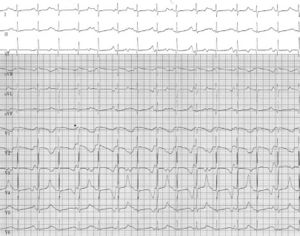Abnormal Repolarization, Spot Diagnosis?: Difference between revisions
Jump to navigation
Jump to search
m (New page: {{NHJ| |mainauthor= '''A.A.M. Wilde, N.A. Blom''' |edition= 2007:03,114 }} Figure 1|thumb A boy with a birth weight of 3.030 g was born by caesarean ...) |
mNo edit summary |
||
| Line 18: | Line 18: | ||
[[Puzzle_2007_03_114_Answer|Answer]] | [[Puzzle_2007_03_114_Answer|Answer]] | ||
Revision as of 20:27, 8 October 2007
| Author(s) | A.A.M. Wilde, N.A. Blom | |
| NHJ edition: | 2007:03,114 | |
| These Rhythm Puzzles have been published in the Netherlands Heart Journal and are reproduced here under the prevailing creative commons license with permission from the publisher, Bohn Stafleu Van Loghum. | ||
| The ECG can be enlarged twice by clicking on the image and it's first enlargement | ||
A boy with a birth weight of 3.030 g was born by caesarean section at 33 weeks of gestation because of bradycardia and severe foetal hydrops. Physical examination at birth showed a hydropic neonate with a heart rate of 70 beats/min. He had cutaneous syndactyly between the fourth and fifth fingers of the left hand. During the first week of life he suffered from polymorphic ventricular arrhythmias for which β- blocker treatment was started and an epicardial pacemaker (VVI) was implanted. An ECG a few weeks later is shown in the figure. What is your diagnosis?
